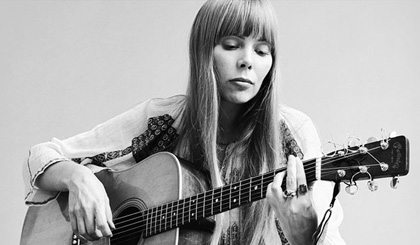
Photo: Jack Robinson
by Dave Blackburn
First, use a guitar with a very firm neck, if you have a choice - (the Taylors are the best as they have a special neck joint that doesn't flex when the string tension is altered). Note that changing string and neck tension on a guitar usually takes a few hours (or even days) for it to acclimate. If you have more than one guitar, consider keeping them in Joni tunings, leaving one in standard.
Second, use custom string sets if you have to. Elixir sell Light/Medium sets which are heavier on the bass strings and lighter on the treble, ideal for Joni tunings. A typical Joni tuning might drop your bass strings by a third or fourth so you can expect them to be floppy. But heavier gauge strings will help as they are higher tension to start with. A baritone guitar, such as the Alvarez ABT60 is ideal for playing Joni's music, as it is designed to be tuned low, with the string tension correct. However, the strings that come with a baritone are intended for B to B tuning (BEADF#B) and a typical Joni tuning might be CGDEGC, so although strings 1,2 and 6 are very close in tension, strings 3,4 and 5 are not, so you'd have to substitute strings that are as close to the intended pitches as possible - within a half step is ideal.
Third, practice playing the songs with a light left hand touch. When the strings are tuned low you are basically stretching the notes sharp as soon as you fret them. Learn to press the string only to the fret and not beyond towards the fretboard wood.
Fourth, and this is something that takes patience, use a tuner (must be chromatic) to get you in the zone but finish by ear. Unless you are using a baritone guitar as described above, the bottom string, when open must usually be tuned flat by as much as 12-15 cents for it to sound somewhat in tune when you fret it. As the tension on the strings is now wildly different from what they were designed for, they will behave strangely and probably buzz. If so, you may need to raise the action slightly. The open bass string may sound flat but the fretted string sharp. You have to find a happy medium and be prepared to live with it not being perfect.
Finally, you'll notice Joni favored a lot of chorus or flanging on her later albums (and even had the Roland Jazz Chorus amp built for her in 1976). Chorus helps a lot by making the pitch center more swimmy and thus hides many of the guitar's tuning problems. I'd recommend using a little chorus. On Hejira most of the tunes used double tracked guitars and phase shifting for modulation.